If you’ve been reading, you may have noticed that I make many projects utilizing wool felt. Quite often, the felt I’m using is from my bloggy buddy Ellen, who sent me an amazing stash of felt during our Package Pals exchange last January. I have gotten so much mileage out of that bundle of felt – check out just some of the projects I’ve made:
So I asked Ellen if she would guest post and give us the low down on felt, since I love to use it in projects but haven’t really dug too deep into the art of felting (or fulling, as Ellen informs us!). So without further delay, here’s Ellen:
Jenn asked me to guest post about how to make wool felt. Jenn and I were Package Pals a while back (read about our exchange here and here) and I sent her a few pieces of wool felt to work with (I think she liked it!). So here is a tutorial for how to make your own from repurposed wool items.
I make all sorts of things from wool felt, I actually prefer it to the regular craft felt you can buy. It has more body and just is nicer.
I make my felt from wool sweaters, blankets, hats, scarves, dresses, coats, jackets and find them at yard sales, auctions, thrift stores and second hand stores.
I use the process of fulling to create felt. I have actually received blog comments from some folks pointing out that what I called felting was actually fulling. Basically (at least in my mind) it boils down to this…if you start with something woolen already made (woven, knitted, crocheted, etc) you are fulling it when you attempt to shrink it to produce felt as the end result.
Fulling by definition is the process in which the woven or knitted cloth is subjected to moisture, heat and friction causing it to shrink considerably in both directions and become compact and solid. In heavily fulled fabrics both the weave and the yarn are obscured, thus giving the appearance of felt.
As an example, here I have made a pair of slippers for myself out of some 1970s wild variegated yarn that I found at a second hand store. The slipper on the left has already been fulled, thus shrinking it both ways.
This is the same sweater, showing the stitches and the yarn on the left, the right side shows a more compact felt appearance.
Felting is an ancient technique that produces a non woven sheet of matted material which is most frequently made from wool, hair or fur created by the entanglement of a mass of fibers that takes place when heat moisture and pressure are combined.
This is one of my few attempts at wet felting. Not my cup of tea…much more time intensive! The brown felt was made from llama roving (processed wool).
Look for labels that say 100% wool, Shetland, merino, lambs wool, cashmere (although it won’t felt as thickly as other wools), camel, alpaca. I will use some wool that is >90% wool content with mohair or angora…when fulled these will be fuzzier.
Avoid labels that list <90% wool or say wool blend. This sweater says wool cashmere blend on the main tag, but after locating the actual contents tag near the bottom of the sweater, I found it contains 30% viscose which is a lovely fiber but doesn’t shrink at all. So that’s a no go! Also avoid any items that says superwash or list washing instructions. Wool items should be dry cleaned so look for that on the tag.
Here’s the before in this brown sweater I bought today to show you a few things….see the shoulder seams?
And here’s the after fulling…no shoulder seams now! And see how the yarn is not as visible?
OK, so now you have your items ready to full (or shrink). Start by grouping like colors together. I put mine inside a zip pillow cover, and full lots of items together.
Set the washer for hot water, and the longest regular cycle you can run. Add detergent (the usual amount for the load size) but never fabric softener and a pair of old tennis shoes, several tennis balls, or those dryer balls that are spikey. I have wool dryer balls that I use too because it seems to help the wool stick to them and makes a bit less of a mess. Either way, it is going to be a fuzzy mess!
Sometimes I run two cycles, sometimes just one. If the felt is not tight/dense enough for you, wash it again. You want the zip pillow covers to be loosely filled so the pieces can move around inside them. Another reason to use the zip covers is to contain the fuzz that is a by product of fulling. Some fellow crafters will not do this fulling in their own washers, preferring to take them to the coin laundry so it creates less lint in their own washer/dryer.
I check in on the progress of the felting several times during the cycle, just ‘cause I’m crazy like that. But, I must warn you about the smell of wet sheep (or camels or llama or the like) that emenates from the washer, and if you used old sweaters, think of a wet sheep smell combined with mothballs! Mmmm, lovely!
So now, remove the wool items from the zip case outside if you can, otherwise there will be fuzz all over, shake each piece well, inspect it to make sure it is compact enough for you and then put it in the dryer on high heat. I clean the lint filter at least two times during the drying cycle. Once everything is dry, you have wool felt!
This purple felt was made from a knit scarf…it has more texture, but I loved the colors!
If your felt is especially fuzzy you can use this sweater stone (get one here for just $5.99 shipping/handling or you can buy them at Target, Eddie Bauer, and several other online stores) to remove the extra fuzz. The stone is swiped across the felt and removes the excess fuzz and also works great for other sweaters too!
The left side of this sweater has been “stoned†and the right side has not yet, see the difference?
One of these sweaters is Gap brand and one is Old Navy…they make the best wool sweaters to felt! Now you have ready to use felt….what are you going to make from it? Here’s some ideas!
Thanks so much Ellen! I feel like I can tackle fulling my own woolens with your helpful tips.

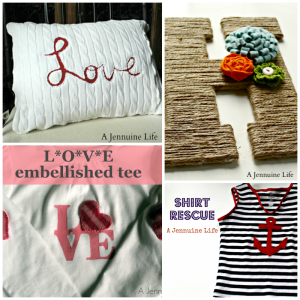
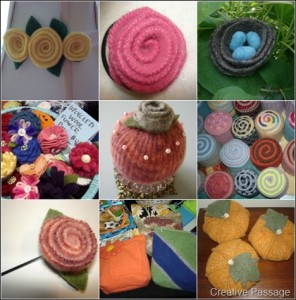
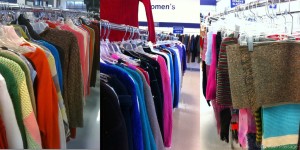
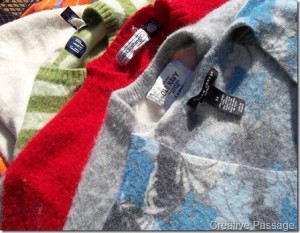
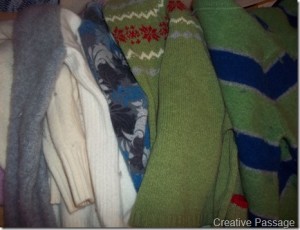
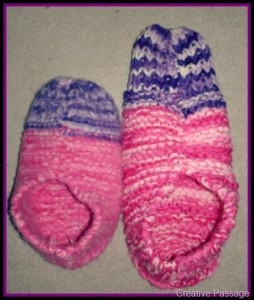
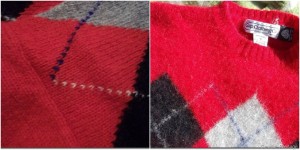
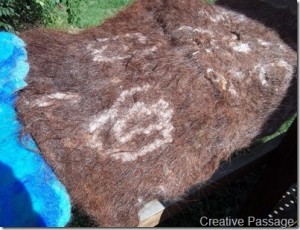
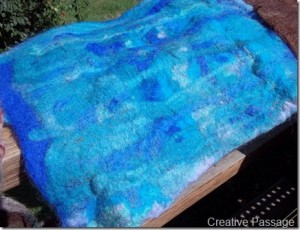
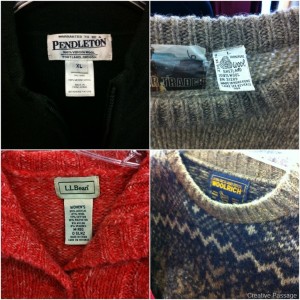
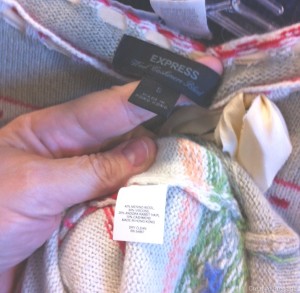
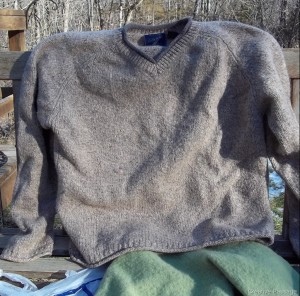
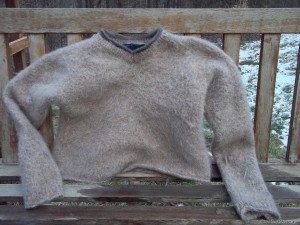
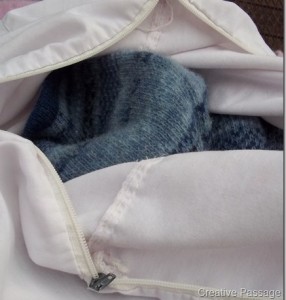
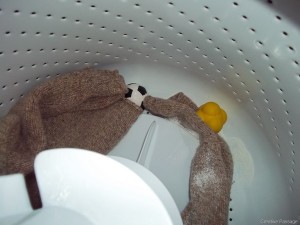
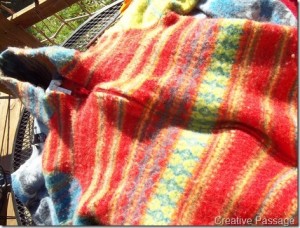
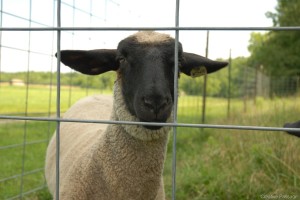
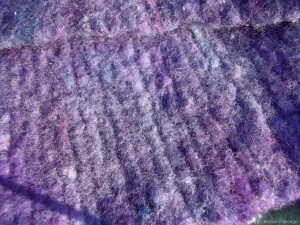
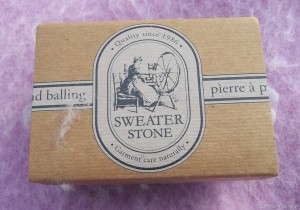
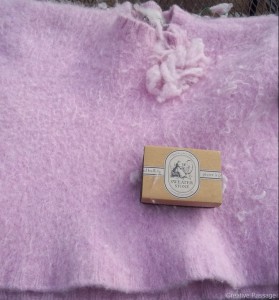
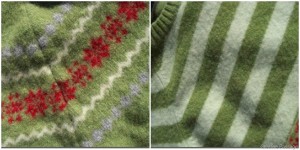
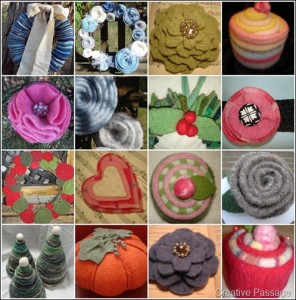



[…] home, I gathered up the supplies including the sweater I had fulled. I had some fine-whale corduroy leftover from a recent project and also grabbed some fusible […]